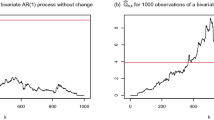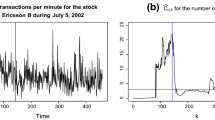Abstract
The change point detection (CPD) problem in a time series is when it is found that the structure of the data being generated has changed at some time and for some reason. We have formulated structural change detection in a time series as an optimal stopping problem using the concept of dynamic programming (DP), and we present the optimal solution and its correctness by numerical calculations. In this article, we present the solution theorem and its proof using reduction to absurdity.
Similar content being viewed by others
Explore related subjects
Discover the latest articles, news and stories from top researchers in related subjects.References
Jana R, Dey S (2000) Change detection in Teletraffic Models. IEEE Trans Signal Processing 48(3):846–853
Kruegel C, Vigna G (2003) Anomaly detection of web-based attacks. In: Proceedings of ACM conference on computer and communication security, pp 27–31, October
Hirose S, Yamanishi K (2008) Latent variable mining with its applications to abnormal behavior detection. In: Proceedings of 2008 SIAM conference on data mining, pp 231–242, July
Julish K, Dacier M (2002) Mining intrusion detection alarms for actionable knowledge. In: Proceedings of the eighth ACM SIGKDD international conference on knowledge discovery and data mining, pp 366–375, July
Yamanishi K, Maruyama Y (2005) Dynamic syslog mining for network failure monitoring. In: Proceedings of the eleventh ACM SIGKDD international conference on knowledge discovery and data mining, pp 499–508, August
Kawano H, Hattori T, Nishimatsu K (2004) Novel method for structural change detection in time series using DP with an action cost. Proceedings of the IEEE international symposium on communications and information technologies 2004 (ISCIT 2004), October 26–29, pp 114–119, IEEE Catalog No. 04EX897C, Sapporo, Japan
Hattori T, Takeda K, Tetsuya I, et al (2010) Early structural change detection as an optimal stopping problem. I. Formulation using dynamic programming with action cost. Proceedings of the 15th international symposium on artificial life and robotics (AROB15th’10), February 4–6, pp 763–766
Author information
Authors and Affiliations
Corresponding author
Additional information
This work was presented in part at the 15th International Symposium on Artificial Life and Robotics, Oita, Japan, February 4–6, 201
About this article
Cite this article
Kawano, H., Hattori, T., Takeda, K. et al. Early structural change detection as an optimal stopping problem: solution theorem and its proof using reduction to absurdity. Artif Life Robotics 15, 425–430 (2010). https://doi.org/10.1007/s10015-010-0835-2
Received:
Accepted:
Published:
Issue Date:
DOI: https://doi.org/10.1007/s10015-010-0835-2




